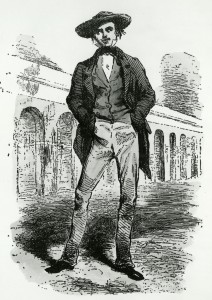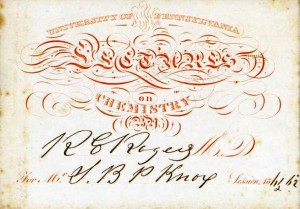
R.E. Rogers. Courtesy of University of Virginia Visual History Collection (RG-30/1/8.801 #16). Special Collections, University of Virginia Library.
Robert Empie Rogers was born in 1813 in Baltimore, Maryland, and was a contributing member of an illustrious family. Each of his three older brothers held professorships as did his father. After graduating from the medical school at the University of Pennsylvania in 1836, he realized that he was not attracted to the practice of medicine. Consequently, he focused on chemistry and worked with the first Geological Survey of Pennsylvania from 1836 to 1842 with his brother, Henry. He was invited to teach chemistry at the University of Virginia where another brother, William, was a professor. Filling in for the ailing Dr. John Emmet, Robert Rogers was then elected to the position of Professor of Chemistry and Materia Medica. He was on the faculty at Virginia from 1842 through 1852.1

The Student, Sketch by Porte Crayon, 1853. Courtesy of University of Virginia Visual History Collection (prints10511). Special Collections, University of Virginia Library.
In 1845, following several years of student unrest, a string of serious riots erupted as students damaged University property, fired pistols, and rode horses around the alleys and arcades of the University grounds. Dr. Rogers at one point hid behind his pavilion pillar, and as students were marching by, grabbed one of the agitators and carried him into the pavilion hall while threatening to shoot anyone who interfered.2
The 1850 census lists Rogers, who married Fanny Montgomery in 1843, as living with his wife and his brother, William, and William’s wife, Emma.3 The slave schedule names William Rogers as the owner of six slaves.4 Robert left the University of Virginia to take the place of his brother, James, who had been the Professor of Chemistry at the University of Pennsylvania until his death in 1852. In 1856 he became Dean of the medical faculty at the University of Pennsylvania.5
During the Civil War, Dr. Rogers was appointed an Acting Assistant-Surgeon in the Army of the United States and served at the West Philadelphia Military Hospital from July 1862 to June 1863. His first wife having died, he married Delia Saunders in 1866. He was President of the Humboldt Oil Company which was formed in Pennsylvania in 1864. The company bought land and drilled wells but was unable to turn a profit. Dr. Rogers was the largest shareholder and lost more than anyone when the company was sold in 1873.6

Lecture card signed by R.E. Rogers. Courtesy of the Collection of Dr. Michael Echols and Doug Arbittier, American Civil War Medicine and Surgical Antiques, website accessed 16 January 2013.
In 1872 he was on a committee to examine the waste of silver while converting bullion into coin at the Philadelphia Mint. He continued to use his skill as a chemist and metallurgist at the San Francisco Mint and in New York for the Assay Office. He left the University of Pennsylvania in 1877 to accept the position of Professor of Medical Chemistry and Toxicology at Jefferson Medical College and was heartily welcomed at his first lecture by an estimated 1,200 people. In July 1884 he resigned his position and was elected emeritus professor. He died in September of the same year.7
Dr. Rogers authored or co-authored 28 papers and published a chemistry textbook. He was involved with the Franklin Institute starting in 1838 and continued in a number of roles, including president from 1875 to 1879. He was elected to the American Philosophical Society in 1855 and served on its Council. He was a Fellow of the College of Physicians and a member of the American Medical Association, first representing the University of Virginia and then the University of Pennsylvania.8
- W.S.W. Ruschenberger, “A Sketch of the Life of Robert E. Rogers, M.D., LL.D., with Biographical Notices of His Father and Brothers,” Proceedings of the American Philosophical Society 23, no. 121 (January 1886): 125-126, accessed 29 March 2011. [↩]
- Philip Alexander Bruce, History of the University of Virginia, 1819-1919; The Lengthened Shadow of One Man, vol. 3 (New York: Macmillan, 1921), 113. [↩]
- U.S. Census: Albemarle, Virginia, 1850, accessed 29 March 2011. [↩]
- Slave Schedule, 1850, Federal Census, Albemarle, Virginia (Charlottesville), accessed 23 March 2011. [↩]
- Ruschenberger, 127. [↩]
- “Sketch of Robert Empie Rogers,” Popular Science 49 (October 1896): 838-839, accessed 2 August 2011. [↩]
- William Barton Rogers, Chronology, accessed 29 March 2011; Ruschenberger, 127-129, 132-133. [↩]
- “Sketch of Robert Empie Rogers,” Popular Science 49 (October 1896): 840-841, accessed 2 August 2011. [↩]

